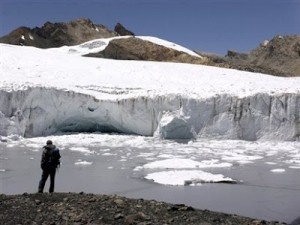 Ice fields in Andean South America are rapidly losing volume and in most cases thinning at even the highest elevations, contributing to sea-level rise at “substantially higher” rates than observed from the 1970s through the 1990s, according to a study published recently. The findings spell trouble for other glaciers worldwide.
Ice fields in Andean South America are rapidly losing volume and in most cases thinning at even the highest elevations, contributing to sea-level rise at “substantially higher” rates than observed from the 1970s through the 1990s, according to a study published recently. The findings spell trouble for other glaciers worldwide.
The rapid melting, based on satellite observations, suggests the ice field’s contribution to global sea-level rise has increased by half since the end of the 20th century, jumping from 0.04 millimeters per year to about .07 mm, and accounting for 2 percent of annual sea-level rise since 1998.
The southern and northern Patagonian ice fields are the largest mass of ice in the southern hemisphere outside of Antarctica. The findings spell trouble for other glaciers worldwide, according to the study’s lead author, Cornell University researcher Michael Willis.
“Patagonia is kind of a poster child for rapidly changing glacier systems,” he said in a statement. The region, he added, “is supplying water to sea-level at a big rate compared to its size.”
The study was published in the journal Geophysical Research Letters.
Melting glaciers, both in South America and the Himalaya, are a major concern to populations downstream who depend on the ice fields as a reservoir providing a steady summer water supply for drinking and agriculture.
Scientists suspect the Andes, for instance, have already surpassed “peak water” and that hundreds of thousands of people living downstream of the glaciers in Peru and Ecuador now face a future of lower flows and increased variability in local rivers.
The new study compared satellite imagery from two different missions over a 12-year period starting in 2000. On average, they found, the Southern Patagonian Icefield glaciers thinned by about six feet per year during that period. Some glaciers were stagnant; others even advanced slightly, Willis said. “But on the whole, retreat and thinning is prevalent.”
Warming air temperatures contributed to the thinning throughout the mountain range, Willis noted. And the warmer temperatures increased the chances that rain — as opposed to snow — would fall on and around the glaciers. That double threat increases the amount of water under the glaciers, decreasing friction and moving more ice to the oceans, he said.
Other researchers said the new study could provide valuable information for future predictions, said Alex Gardner, an assistant professor at Clark University in Massachusetts, who was not involved in the study but researches glaciers and ice sheets. “A study like this really provides a strong data set to validate and calibrate glacial models,” he said in a statement.
Source: http://www.bluechannel24.com/
Пожалуйста, ответьте на наши опросы. Несколько минут, потраченных вами на голосование, позволят нам понять, как сделать наш сайт и портал более интересным и нужным!


